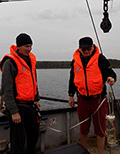Due to the COVID-19 pandemic, there were exceptional circumstances during the spring 2020. There were challenges to carry out SEVIRA-project according to the plans, but nevertheless the project has continued successfully. Nearly all planned activities have been realized.
Monitoring
River monitoring has been going on both in Finland and Russia, even if some adjustments and changes have taken place compared to the original plan. In Vesikirje (“water news-letter”, in Finnish only) there is more about monitoring activities in emergency conditions.
I addition to the COVID-19, the climatic conditions during the winter were very exceptional with very mild weather and excessive precipitation. It is of great interest to see how these specific conditions have influenced to the environmental condition of rivers and coastal waters. The measured data, both from Finland and Russia, are now under investigations. The results will be reported in August.
Spring time is always challenging for measurements systems with rapidly changeable meteorological and hydrological conditions. The automatic station has functioned relatively well. However, there was a short break in the measurements at the time of the ice breakup. Meanwhile, one sensor was damaged. Unfortunately, this problem can be fixed only when the Finnish-Russian border will be opened again.
The first SEVIRA-blog was written by Sirkka Tattari about on-line monitoring:

© NWAHEM.
Coastal monitoring was carried out during week 24 in June. On the Finnish side, samples were taken from six coastal stations near the border, situated at the SEVIRA-project area. The measured data are subjected to normal coastal monitoring analyzes. In Russia, sampling was also arranged at agreed points in Vyborg Bay during the same period. The idea was also to carry out an intercalibration and to compare monitoring data with the satellite data. As for now it is not possible to get reference samples to Finland, these will be frozen waiting for later collection.
Modelling
First results from the SWAT-model has been presented during the All-Russian Youth Conference:
During the spring and early summer, the modeling team has built the Rakkolanjoki SWAT application. In the first model runs, the runoff was too high and the evapotranspiration correspondingly too small. Similarly, the level of nutrient loading was too high. The point load from the Finnish side was added to the model as initial data and one lake in the area was added to the model as a reservoir. Additional runoff of water into the river was considered in the calibration of the model. By adjusting the parameters, acceptable output is obtained now. Cooperation between the parties has functioned well and regular Teams meetings are organized.
Public awareness
For raising the awareness of citizens and schools, SEVIRA-project now offers water test packages (in Russian) suitable for water monitoring, together with the Järviwiki service. Guidelines have been prepared for monitoring Secchi-depth, temperature, algal situation, turbidity, pH and dissolved oxygen. Observations can be submitted to the Järviwiki service in own language. Secchi-depth has been measured in Rakkolanjoki since 1966 by researchers and now by several citizens and by schools. The three-day field research trip planned for Russian and Finnish schools had to be postponed to spring 2021 due to the COVID-19.
Regarding to the surveys for the residents in the Virojoki and Rakkolanjoki catchments, planning of the questionnaires has progressed to the testing phase. The advisory group, consisting of members from the SEVIRA steering group, has also been involved in the planning and testing phase.
In addition, the survey for the Sestra catchment will be planned in cooperation with the Russian partner. The project has continued very much according to the plans, even if the circumstances have been challenging.